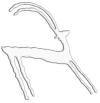Ērān ud Anērān
Webfestschrift Marshak 2003
[index]

Ērān ud Anērān |
Transoxiana
|
In this paper I publish the remaining three ostraca from Old Nisa, known only from the photos in the archive of South-Turkmenistan expedition. One of these three ostraca is particularly interesting because it bears a king's name and genealogy.
The three documents which are the subject of the present article were found in 1955 at the archaeological site of Old Nisa, in the wine-store. Their photos were preserved in the archive of South-Turkmenistan complex archaeological expeditions and were unknown to academic world until 1986 when archaeologist S.D. Loginov (Institute of History, Turkmenistan Academy of Sciences) found these photos. It is so far unknown to me, where the ostraca are kept and for what reason they were not brought to State Hermitage for research unlike all the other ostraca from Nisa.
As far as I can judge from the photos, one of these three documents (No. 1-L, fig. 1)1 represents the most typical formula of the Nisa documents, which records a receipt of wine from a certain "estate".
Text2:
"(1) In this pithose there is 20 [+?] mari of wine. (2) Brought by wine-factor Bagindāt4, (3) who is from (the village) Wardmatak5. From (4) an uzbari vineyard which (is) (5) [in the "estate" [Ar]tabā[n]ukān, (6) called Ar[tax]šahrakān, (7-8) delivered for the year 206".
The next document is more interesting (No 2-L, fig. 2):
"Aršak, the king, son of grandson6 (2) of Aršak. Accounted (3) this offering – 2000 e(phas) of barley".
The genealogy of the king mentioned in this document shows that he was one of three great-grandsons of Aršak the 1st, the founder of Parthian dynasty. Thus he can be identified with either Frahāt the 1st (ca. 176-171 BC), Mihrdāt the 1st (ca.170-138 BC), or, finally, Artabān the 1st (128-123 BC). In any case this record is dated back to the 2nd century BC and thus, likewise the document 2673 (152-151 BC), is one of the oldest texts from Nisa. The word npt = napāt"grandson" (cf. MPers. nab) is attested also in the badly preserved document No. 2640; in No. 2638 "grandson" is rendered by an ideogram BRY BRY = puhrēpuhr7.
The ideogram Q'YLw is repeatedly attested in the documents from the wine-store of Old Nisa, and its meaning is apparently clear (likewise its variant Q'YLt, with Parthian grammatical complement -t). An Aramaic root of this ideogram, however, remains unclear.
This is the first case when we meet ideogram NDBT' in Parthian. Its meaning is "gift, volunteer offering", a derivate of Aramaic root nadaba "to present as a gift, to offer". From this root we have nẹdabấ (st. const. ndbt') "gift"8. In Bibl. Aram. and Hebrew this word is recorded repeatedly, most often with the meaning "donation, volunteer, optional offering" (this word was apparently used to designate the offerings to the Jerusalem Temple – Ezra, 1,4,8,28 etc., gifts above fixed offerings – Levit, 23, 38, etc.; donations for sacred meals – Deuteron, 12, 6).
A Parthian correspondent for NDBT' is unknown. From this document we know that the subject of "this offering" (NDBT' ZNH) was barley – Ś'RN (Aram. śa'ārīn, Pl.), the ideogram for Parth. yaw, cf. Pahlavi Šg – deformed abbreviation of Aramaic word, designating Middle Pers. jàaw. The measure of volume is abbreviated as ', for Aram. 'ēphā ('yph); itwas about 35 liters. This gift of 2000 'ēphā looks a solid donation. This ostracon apparently served as a label to for a storage where this heap of barley (ca. 70 ton) was kept.
The inscription on the third ostracon, from the photo found by S.D. Loginov, is a short registration (No. 3-L, fig. 3):
"(1) In this jar (2) wine gone so[ur] (or – vine[gar]).
Here wytr is lapsus calami for wytršpk "sour".
![[Missing Image]](Images/livshits_01a.gif)
Fig. 1a
![[Missing Image]](Images/livshits_01b.gif)
Fig. 1b
![[Missing Image]](Images/livshits_02.gif)
Fig. 2
![[Missing Image]](Images/livshits_03.gif)
Fig. 3
1 I use the sign "L" for the documents sent by Loginov.
2 The parenthesis indicate partially damaged letters, while square brackets -completely damaged and restored by the author.
3 At the end of this line the crock surface is jagged.
4 Or Bagāndāt, "Created by Altar", or "Created by the gods". Cf. Arm (from Parth.)bagin "Altar", OIr. *bagina-, *bažina-, Middle Pers. bašnbed, Sogd. βγnpt /vaγnpat/"priest", Slav. *božьnica, see H. Hübschmann. Armenische Grammatik. I. Theil. Armenische Etymologie. Leipzig, 1897, S. 114; W.B. Henning. Sogdische Miszellen. Bulletin of the School of Oriental Studies, Vol. III, pt. 2-3, London, 1936, pp. 583-588; Etimologicheskiĭ slovar' slavianskikh ĭazykov, vypusk 2, Moscow, 1975, p. 229.
5 Wrdmtk = Wardmatak, from ward "flower, rose" and Avest. mati- "Vorsprung (des Gebirges)".
6 I.e. great-grandson.
7 See I. Gershevitch. Genealogical descent in Iranian. Bulletin of the Iranian Culture Foundation, I, Tehran, 1973, pp. 71-86.
8 J. Hoftijzer and K. Jongeling. Dictionary of the North-West Semitic Inscriptions, Part I, Leiden-New-York-Köln, 1995, p. 716; K. Beyer. Die aramäischen Texte vom Toten Meer. Göttingen, 1984, S. 633.
Actualizado el 24/07/2004